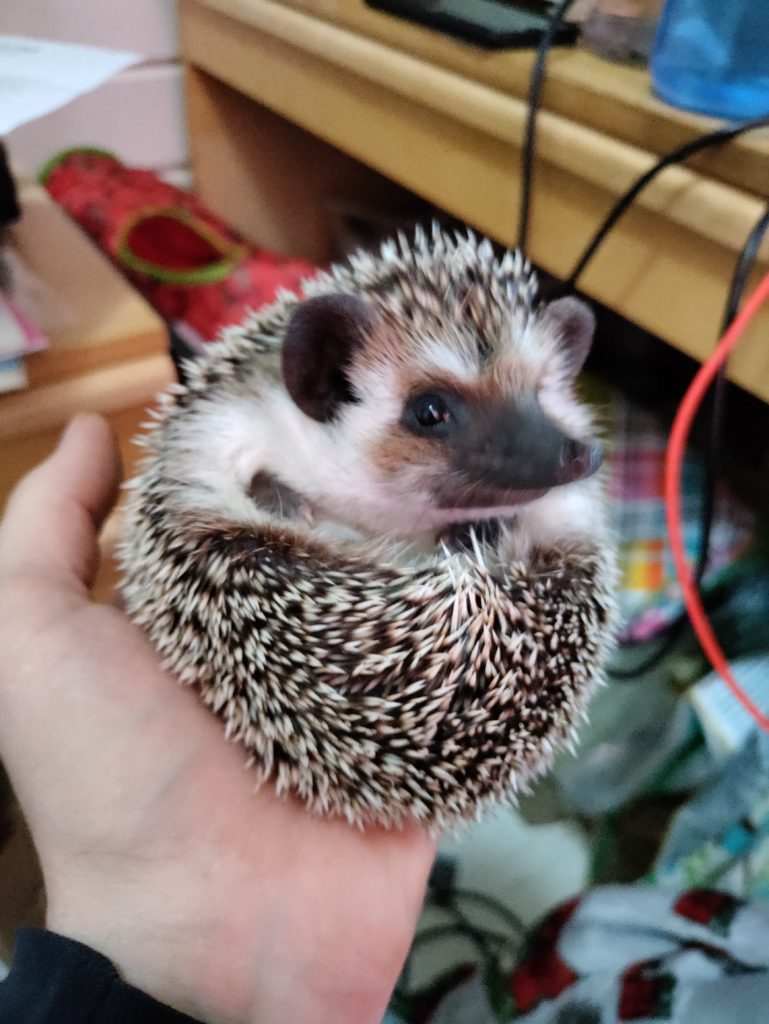It’s been ages since I made a post, so there’s plenty to catch up on!
Rambutan Arrives!

We brought how our new hedgehog Rambutan on October 2nd and introduced her to her new habitat, which she seemed to take to right away. We had purchased a hide for her that hadn’t arrived yet, so we put a snuggle sack in the habitat for her for the first week or so of her stay. Needless to say, any fabric items in the habitat are quickly covered in dirt and bits of leaf, so it was a relief to replace the fabric hide with one that would stay more clean, even though I don’t think Rambutan minds at all.
Rambu made short work of most of the plants in her habitat. She pulled up the pony tail palms, ravaged any leafy plants, dug deep pits in the soil nightly which of course disturbed the plants, and generally created hedgie havoc for any plant or arthropod she came across in her habitat. Today, after over 4 months of occupation, a single stand of sedge grasss is the only survivor of her efforts, and yes, it’s time to replant!
Rambu forages each night for isopods, worms, and dubias that are foolish enough to be out in the open while she is on the hunt, and these have been occasionally restocked to keep her habitat rife with excitement. The Powdery Orange isopods seem to be the best adapted to her habitat, and are the only ones that I regularly see when maintaining it.
After about 2-3 months of occupation, the habitat developed a slightly musty smell, and I’ve been managing that by removing any hedgehog poop I can find once or twice a week, which seems to have helped. I expect to replace the soil near her running wheel soon, as this is where she does most of her “business” and is likely the most smelly area in the habitat. This corner is also furthest from the plants and arthropod hides, so it’s not very likely that many of the CUC are getting over there to feed and escaping with their lives.
As winter set in, we had to add a second blanket to the cloth hood over her habitat and wrap styrofoam insultation around 3 sides of the glass aquarium that makes up the base of her habitat to keep things warm enough for her as the temps outside dipped into freezing and the temps inside dropped into the mid 60’s. The deep heat projectors seem to be doing a great job of keeping her warm with these modifications, and was certainly cheaper than buying a 3rd heat projector and thermostat for her habitat.
On the Dubia Front
Mini-dubias first appeared in Novemeber or early December, and looked very similar in size and appearance to isopods to my surprise. These are now growing up as more and more babies are born, and I have no worry about running out of Dubias any time soon! They are fed every other day with fresh fruits and veggies, and are given roach chow on off days to suppliment the fresh food. They receive water refills daily, which usually involves dumping some water in the already-present water crystals to rehydrate them, as the crystals seem easily able to last up to a week this way before they start looking gross enough that I want to toss them and replace them with fresh water crystals.
The Isopods
Many of the isopod varieties have done very well. My favorites are wild “trilobites” that I collected in my garden, that are likely Porcelio Scabers or Spinicornis. They are fearless, and don’t seem to mind when their habitat is moved or disturbed. What sends most isopods scurrying for cover they don’t seem to even worry about, and usually just bobble about like they’re interested in what’s going on or are maybe even excited to see you. They have exploded in population, so are thriving and breeding well in captivitiy. I have planned to keep them for 6 months before putting them into Rambu’s habitat, so to date none have been sacrificed to her cause. The locally-caught Armadillidium Vulgares did a massive die-off about 2-3 months into their captivity, and now there is a very scarce number of them in their habitat.
I’ve had to move a couple iso populations to new habitats after their existing ones were overrun with mold and fungal colonies. Even though these habitats were swarming with springtails, they didn’t seem to keep the mold and fungi in check as advertised, and I ultimately decided to move my two wild collections and the zebras to fresh habitats, and the powdery oranges will be the next to be moved out of their fungus-y habitat into some fresh subtrate soon.
Each colony gets fed every 3 days and spend the rest of their time tucked neatly onto a shelf in my office. Any un-eaten food is removed at each feeding, and fresh leaves are added as needed. Each habitat gets a little water on it’s ‘wet’ end of the enclosure, any other issues noticed get addressed as needed, and that is it!
The REAL Superworms and Mealworm Update
Ok, in my ignorance, I somehow managed to NOT buy superworms when I started up my worm growing operation. Instead, I apparently came away with a container of jumbo mealworms, thinking they were superworms, and proceeded to raise them along site a second population of regular mealworms. I religiously moved the faux-superworm beetles to fresh enclosures each month so they would continue to breed and lay eggs in the fresh substrate, resulting in about a half dozen seperate tupperware over several months containers with faux-superworms of various sizes living in them.
I finally came upon some REAL superworms at the pet store in the last few weeks, and immediately realized that my faux-superworms were certainly not the vigorously thrashing, tubular titans I was now bringing home. In light of this, I was able to re-combine the many faux-superworms into a single container with the mealworms, fully demoting them to their actual status, which if nothing more freed up some room and several tupperware containers in my office. I fed the REAL superworms well for a couple weeks, then started to pupate them, which they have been doing at a rate of about 1 per day, producing large plump looking pupas.
The mealworms, in spite of the confusion around them are prolific and doing well. I’ve moved most of them to a soil-based substrate rather than using all oats or bran, as I struggled with grain mite infestations in some of the earlier containers and using soil seems to be a good way to address that, though I’m still working on figuring out how much and how often to feed them in this substrate, since they can’t just eat the world around them if they run out of carrot in this setup.
